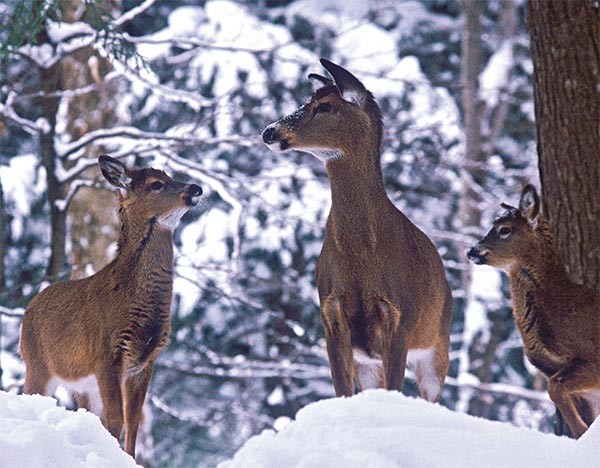
When Maine zoned two percent of the northern part of the state as deer wintering areas in the 1970s, its goal was to provide habitat that would increase deer density to 10 animals per square mile. But recent analysis by a University of Maine researcher found that strategy to be ineffective and the goal unattainable. After more than 35 years, the region is thought to have just one to two deer per square mile.
Professor Daniel Harrison and postdoctoral researcher Erin Simons-Legaard examined satellite data as far back as 1970 to evaluate habitat changes in the 190,000 acres of deer wintering area comprising 981 management units. “Deer require late successional conifer forests for wintering, but a lot of those areas have been subject to harvesting through the years,” said Harrison. “The perception is that loss of deer wintering habitat may be contributing to the fact that deer don’t attain the densities that they used to. But before we get into more zoning, I wanted to see how well historical zoning has performed.”
Despite zoning that prohibited the harvesting of trees without a special variance to improve deer wintering habitat, Harrison found that 91 percent of designated deer wintering areas contained at least one heavily harvested area, and 23 percent of the mature forest within those areas had been harvested between 1975 and 2007. More importantly, within a 1.25-mile buffer around the deer wintering areas, mature conifer forests declined precipitously and what remained became fragmented. “We were investing a lot to conserve core wintering areas, but the landscape integrity of areas around them was heavily impacted,” Harrison said. He also found that, by 2007, less than one percent of the landscape included remnant patches of mature conifer forest greater than 250 acres, which is the size deer need for wintering. To reach the state’s goal of conserving 10 percent of the landscape as deer wintering areas by 2030, nearly every remaining conifer forest larger than 12.5 acres would need to be protected, even though much of that land would not be useful to deer.
Harrison concluded that the goal of 10 deer per square mile is not achievable with current habitat availability, and he doesn’t believe that’s an appropriate goal anyway. “Oftentimes, the public sets goals based on what our grandfathers remember seeing, even when those targets never really occurred on the landscape naturally,” he said. “The deer densities present in northern Maine in the 1940s and ’50s and ’60s were an exception, something that didn’t occur prior to the white man arriving in the north Maine woods. They weren’t present in 1900. Those densities only occurred during a period of time when we had extensive winter cover with harvests providing areas of high quality food, and when there were no canid predators.” He believes that deer goals for the region should be re-evaluated and new goals established using a multispecies management strategy.

